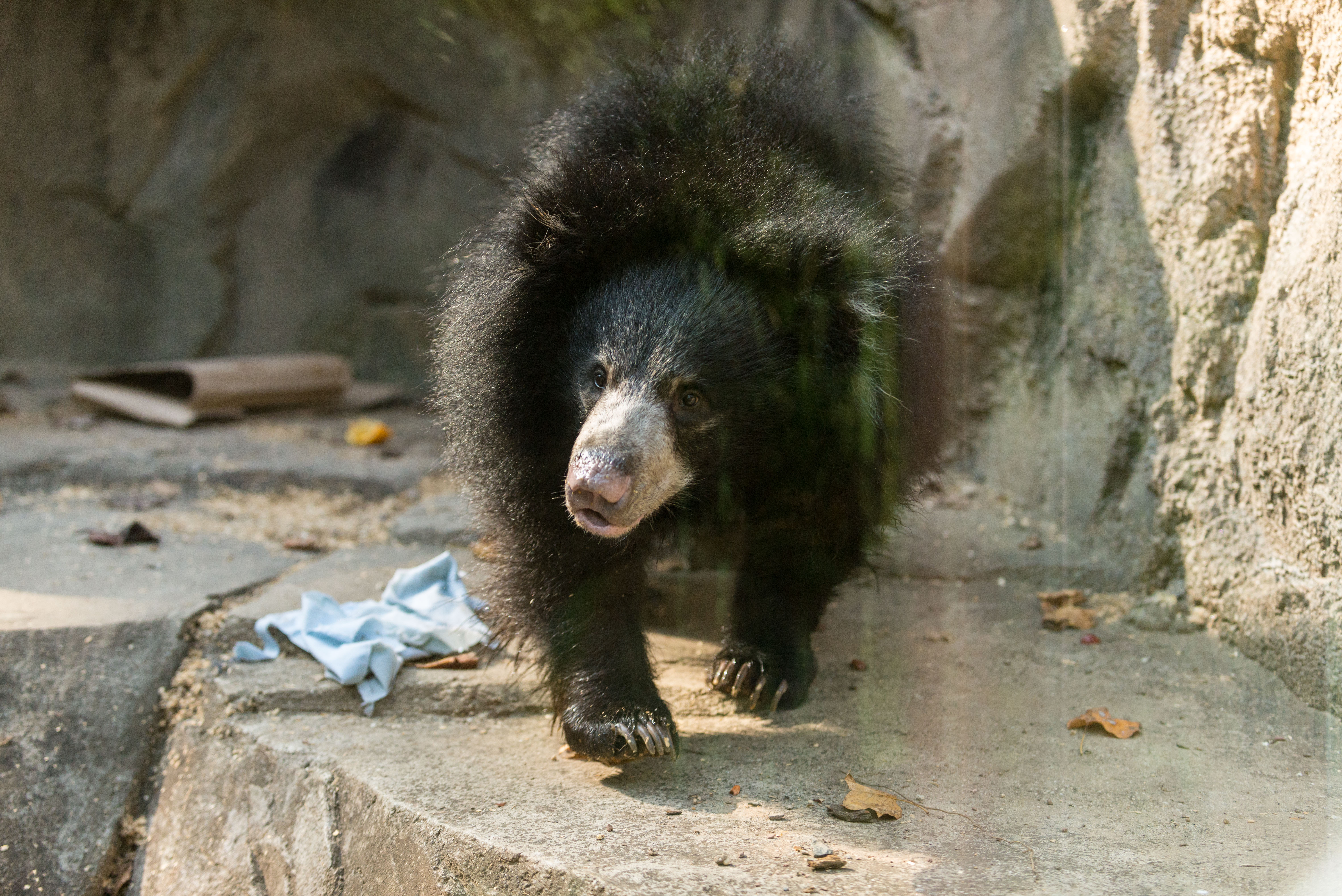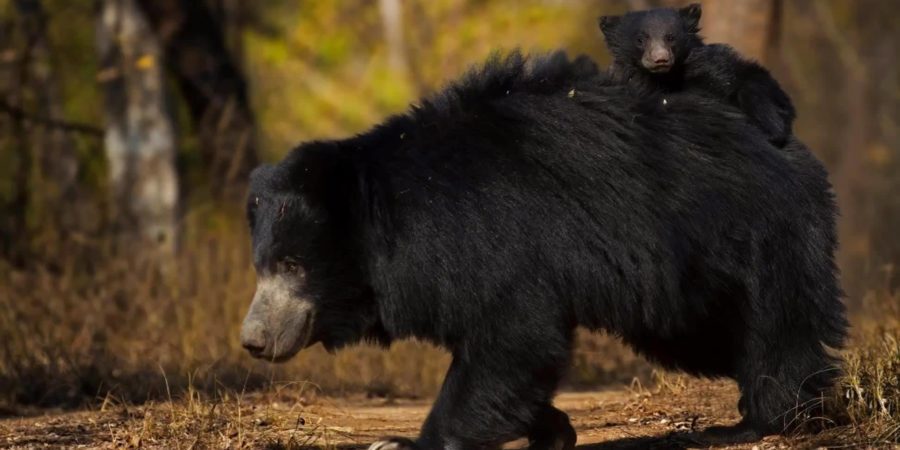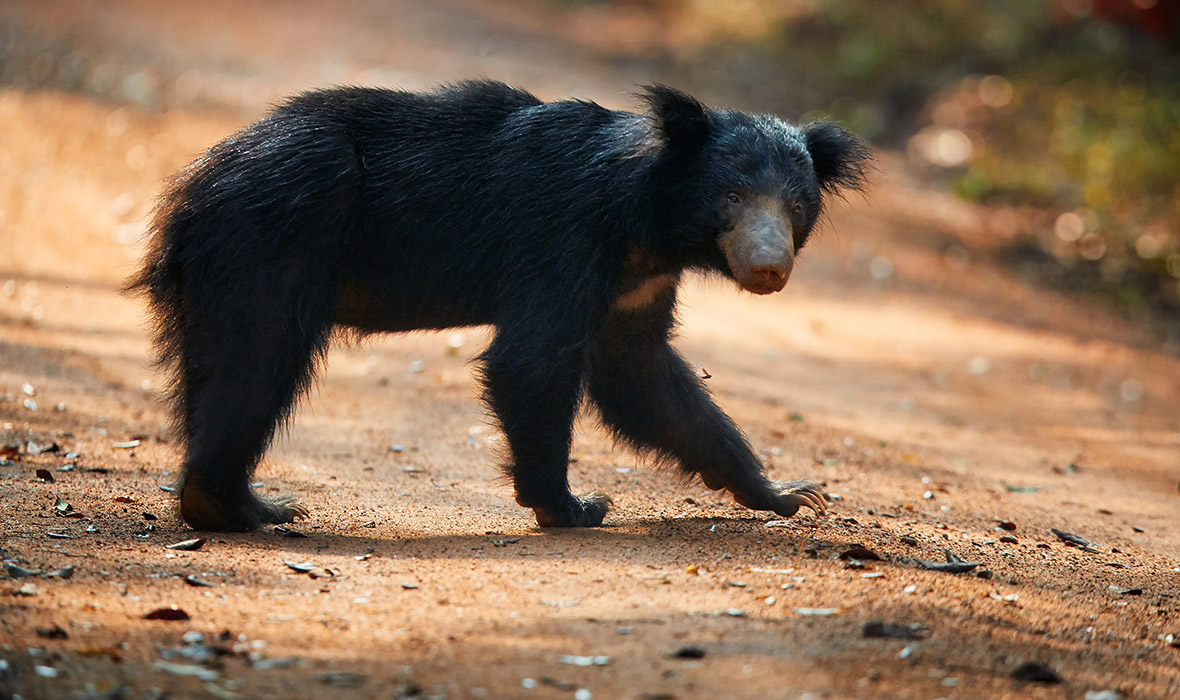A Sloth Of Bears
Sloth bears are large mammals native to India. These bears are unique in their dietary habits, as their primary food source is insects! Like many other bear species, humans have threatened them with extinction, primarily through to habitat loss. Because of this, the IUCN Red List labels them as Vulnerable. The Sloth bear is a myrmecophagous bear species native to the Indian subcontinent. They primarily eat termites and ants and have also been called 'labiated bears' because of their long lower lip and palate used for sucking insects. Sloth bear definition is - a forest-dwelling bear (Melurus ursinus) of India and adjacent regions that has long black hair, very large claws, and a long snout and that feeds chiefly on insects. The sloth bear is a type of bear native to India, Sri Lanka, Bangladesh, Butan, and Nepal. They can weigh from 120 to 310 pounds (54 to 141 kilos) and are usually five to six feet (1.5 to 1.8 meters) tall. The sloth bear is an omnivore, eating insects, fruit, and carrion.
- Sloth Bear Predators
- A Group Of Bears Is Called A Sloth
- A Sloth Of Bears Meaning
- Sloth Bear Habitat
- A Sloth Of Bears
 Physical Description
Physical DescriptionSloth bears have shaggy, dusty-black coats; pale, short-haired muzzles; and long, curved claws which they use to excavate termites and ants. A cream-colored “V” or “Y” shape usually marks their chests. Their shaggy fur does not have an undercoat, so it keeps them relatively cool in their native, warm climate and protects them from tropical insects. Sloth bears' nostrils can close completely, protecting the animals from dust or insects when raiding termite nests or beehives. They have a keen sense of smell, as well as near-sight similar to that of humans.
Adult sloth bears are missing their top two front teeth (incisors), which enables them to suck up termites and other insects with ease. Due to their diet of insects and fruit, their premolars and molars are smaller than those of other bears, but they have large canines to use for defense. It is thought that their feet are turned inward to increase digging efficiency.

The first valid scientific description of this species was by George Shaw in 1791. He called it Ursine bradypus, ursine meaning bearlike and bradypus meaning slow foot. Bradypus is also the genus of three species of sloth. At the time, Shaw thought that the bear was related to a sloth. Time and additional specimens eventually revealed the true taxonomic relationships, but the confusing common name remains.
SizeSloth bears grow 5 to 6 feet (1.5 to 2 meters) long, stand 2 to 3 feet (0.5 to 1 meters) high at the shoulder, and weigh, on average, 200 to 300 pounds (90 to 140 kilograms).
Native HabitatSloth bears live in a variety of dry and moist forests and in some tall grasslands, where boulders, scattered shrubs and trees provide shelter. Their range includes India, Sri Lanka and southern Nepal. Historically, sloth bears have also been reported in Bangladesh and Bhutan, but it is unclear whether sloth bears are still present in the wild of these countries.They are currently considered extirpated, or no longer present, in Bangladesh and may also be absent from Bhutan.
CommunicationSloth bears are noisy, busy animals. They grunt and snort as they pull down branches to get fruit, dig for termites and ants, or snuffle under debris for grubs and beetles.
If threatened, they will stand on two legs, brandishing their clawed forepaws as weapons. Their large canines are used for defense against tigers. Other potential predators include jackals, wild dogs, wolves, leopards and other Asian bear species.
Food/Eating HabitsAs animals who consume termites and ants, sloth bears are considered myrmecophagous. When trees are in fruit, usually during the monsoon season, sloth bears dine on mango, fig, ebony and other fruits, as well as on flowers.
Termites, dug out of their cement-hard nest mounds, and some ants are year-round staples. During non-fruiting season, insects constitute 95 percent of a sloth bear's diet. Sloth bears climb trees and knock down honeycombs, later collecting the honey from the forest floor. Beetles, grubs and other insects round out their diet. During food shortages, sloth bears will eat carrion. They also sometimes raid farm crops.
The Smithsonian's National Zoo's sloth bears eat a dry-food mixture designed for omnivores, plus fruits and vegetables, such as apples, sweet potatoes and grapes. At the Zoo, they are offered food at least three times daily: a large morning meal, a large evening meal and one or more snacks throughout the day. They also receive treats as enrichment, such as mealworms, crickets, nuts, coconut and honey.
Reproduction and DevelopmentIn India, sloth bears breed in late spring to early summer. In Sri Lanka, however, there is no seasonality to sloth bear breeding. Mating occurs over several days to weeks and is very noisy.
While embryonic development takes approximately two months, gestation lasts four to seven months due to delayed implantation. In the weeks to months before a birth, the female may exhibit 'denning' behavior. She digs a den or prepares space in a cave. She may become less interactive, or easily agitated, disinterested in food, defend the cubbing area and sleep more. These behaviors, correlated with hormonal changes, may occur even if the bear is experiencing a pseudopregnancy.
In the North American zoo population, births generally occur in late December to early January. One or two cubs (rarely three) are born in each litter in an underground den. They are born weighing about 1 pound (2 kilograms), open their eyes at about 2 to 3 weeks old and start to 'walk' around 4 weeks. Cubs will nurse for about a year. After emerging from the den at around 9 to 12 weeks, cubs stay with their mother for approximately two to three years before heading off on their own --a long time in comparison to other bears. Sloth bears are the only bears to routinely carry their young on their backs as a primary mode of transportation; the cub clings to the extra shag of fur ('saddle') on the mother's back until it is 6 to 9 months old. Many other animals that primarily consume ants also carry their young on their backs.
Sloth bears are sexually mature at age 3, but are rarely mothers until later in life. They breed once every three years, more often if they have not given birth or have lost their cubs. Sloth bears exhibit low fecundity and high infant mortality. Fifty-three percent of males and 38 percent of females die as cubs.
Sleep HabitsThese bears adapt their sleep-wake cycle to their environment and may be on a nocturnal, diurnal or crepuscular schedule depending on how many other bears, people or predators share their habitat. In protected areas, for example, sloth bears may be more active during the day. Sloth bears are typically active for about eight to 14 hours each day, and they do not hibernate. At the Zoo, they tend to keep a crepuscular schedule, meaning they are active in both the morning and evening but sleep midday and overnight.
Sloth Bears
(Melursus ursinus)
A Sloth or Not a Sloth
In the late 1700's, the first sloth bear pelts were sent from India to Britain.
Dr. George Shaw from the British Museum originally classed them as belonging to the family of sloths, calling them bear sloths.
It was not until 1810, when a live sloth bear was shipped to Paris, that the classification error was corrected and the name reversed to sloth bear.
Population and Distribution
Sloth Bear Predators
It is thought that the sloth bear is in steady decline with somewhere between 7,000 to 10,000 bears still living in the wild. They live in the forests on the island of Sri Lanka, India, Bhutan, Nepal and Bangladesh (see map).
Its preferred habitat includes a wide variety of forests types ranging from the thorn forests of northern India to the wet tropical forests further south. Widespread land clearing and deforestation continue to reduce its available habitat.

Vital Statistics
The sloth bear is a large mammal whose size and weight show high variability depending on food availability, climatic conditions, etc.
Adult sloth bears stand approximately 85 centimeters (2 3/4 feet) tall at the shoulders when on all fours and have a length of about 140 to 170 centimeters (4 1/2 to 5 1/2 feet). Their tail is slightly longer than other bears at 16 to 18 centimeters (6 to 7 inches) long.
The weight of an adult male sloth bear is in the neighbourhood of 127 to 145 kilograms (280 to 300 pounds). Female sloth bears are slightly smaller than males.
Physical Characteristics
Sloth bears have a heavy body, relatively short tail, rounded ears, plantigrade feet (i.e., both heel and toe make contact with the ground when walking in a manner similar to humans). Their feet are equipped with long, curved front claws which are about 7 centimeters (3 inches) long. Their claws make them good diggers and efficient tree climbers. Their gait is a slow, shuffling-type walk but when alarmed, they can gallop faster than a human being.
The sloth bear 's head and dental structure have undergone major evolutionary adaptations. The long white muzzle has extremely protrusible lips and nostrils which can be voluntarily closed by the bear. There are no front incisor teeth and the bony palate within the upper interior of the mouth is hollowed out. The combination of all these changes has produced a bear which can form a very efficient vacuum tube effect with its lips and mouth to suck up its major food source, namely termites.
The sloth bear is covered by a long, shaggy, black coat. The extreme length of the fur on the back of the neck and shoulders tends to give the bear the appearance of having a mane. The sloth bear also has a very distinctive white or yellowish chevron (V-shaped ) marking on its chest.
Diet and Food Sources


Sloth bears, like most wild creatures, seek foods which will return the highest nutritional value for the least expenditure of energy. Seasonal availability and geographic location are the biggest factors determining the primary food sources of sloth bears.
Within the tropics, termite and ant colonies are abundant and stable food sources. Sloth bears have adapted to become specialized termite hunters. The bears will dig into the hard tall pillars where the termites live. They then insert their muzzle to suck up the termites and their larvae. The noise made by this activity is very loud and can be heard up to 180 meters (200 yards) away.
Sloth bears will also climb and shake fruit trees to obtain food. Honey is also a source of nutrition for the bears, as are ants, berries, cultivated sugarcane, corn, cultivated yams and the fleshy flowers of the Mohwa tree.
While not known to be very predatory in nature, sloth bears will eat virtually any carrion which they may discover.
Sloth bears prefer to feed during the night but will feed at any time of the day as necessary.
Home Range
The size of the home range of an individual sloth bear will vary with the concentration of high energy food sources. Thus, the more concentrated the food sources, the smaller the range necessary to maintain an animal.
A Group Of Bears Is Called A Sloth
Sloth bears, more than any of the other bear species, appear to like the company of other bears within its territory. The bears readily communicate with one another using facial expressions and a diverse variety of sounds characterized as roars, howls, squeals, yelps, huffs, rattles and gurgles.
To date, there is no definitive research which details the exact nature of the home range of the sloth bear. Studies involving placing radio-equipped collars on selected bears are currently underway. It is hoped that information will be forthcoming in the near future to assist in establishing the size of the conservation areas that will be needed in order to ensure the survival of these bears in the wild.
Reproduction
A Sloth Of Bears Meaning
In Sri Lanka, sloth bears have been observed mating at all times of the year while in India, mating usually takes place between June and July. Breeding normally takes place in a manner similar to members of the canine (dog) family. It is described as a boisterous occasion with the bears engaging in hugging-like behaviour and mock fighting.
The cubs are usually born sometime between late December and early January to coincide with the dry season. With the gestation period generally being between six and seven months, there is strong speculation that sloth bears may undergo what has been called delayed implementation.
Sloth Bear Habitat
Through the process of delayed implementation, the fertilized ovum divides a few times and then floats free within the uterus for several months with its development arrested. The embryo will then attach itself to the uterine wall and after a period of probably about six to ten weeks, the cubs will be born to the mother who retires to a rock cavity or shelter dug under some rocks or tree roots.
Should there not be sufficient food resources available to the female sloth bear in a particular year, it is presumed that the embryo will not implant and it is simply reabsorbed by her body.
The number of cubs born is usually two and occasionally three. Again, climate and food supply will be important determinants to the size of the litter.
At birth, the cubs are blind and very tiny. They weigh from 300 to 500 grams (11 to 18 ounces). Helpless at birth, the cubs develop quickly and within a month or shortly thereafter, they are able to forage with their mother.
Sloth bear mothers, as they forage, can often be seen carrying the young cubs on their backs. If there is more than one cub, they will establish permanent riding positions such that one cub will always take a position on the shoulders while the other will ride near the rump. This behaviour has been observed until the cubs are quite large, approximating a third of their mother's size.
Adult male sloth bears also appear to be allowed around young cubs. The males appear to be quite gentle and don't display the predatory instincts toward cubs seen in other bears species.
The cubs usually stay with their mothers for two to three years.
Baby and Adolescent Mortality
The survival of cubs is extremely tenuous as it is for most bear species. The exact details of the mortality rate for the cubs of the sloth bear during the first year and subsequent years is not available because of the lack of ongoing research.
The sloth bear cub survival is undoubtedly dependent on the skill of their mother initially protecting them and then teaching them the basics of what to eat; where and how to get it; and how to cope with the dangers of their environment.
The fact, however, that the cubs will stay with the mother for two to three years plus the non-predatory nature of the adult male sloth bear suggests that infant mortality may be less than in other bear species.
A Sloth Of Bears
Hibernation
There is no recorded observations of sloth bears hibernating due to the normal availability of food sources throughout the year. The sloth bear does appears to enter a period of time late in the year when it is somewhat lethargic.
'The Bear Den' Home Page
The Evolution of Bears
The Modern Archetypal Bear
Brown and Grizzly Bears
American Black Bears
Polar Bears
Giant Pandas
Asiatic Black Bears
Spectacled Bears
Sloth Bears (back to the top of this page)
Sun Bears
The Bear Den News
Bear Conservancy Organizations
The Bear Den Book Shelf
The Bear Den Video Guide
The Bear Den In-Depth Reviews
The Bear Den Photo Gallery
The Bear Den Quotable Quotes
The Bear Den Guide to Backcountry Wisdom
Wildlife, Conservancy and Backcountry Web Sites
The Bear Den Comments from Visitors
Would You Like to learn ABOUT exotic PETS?